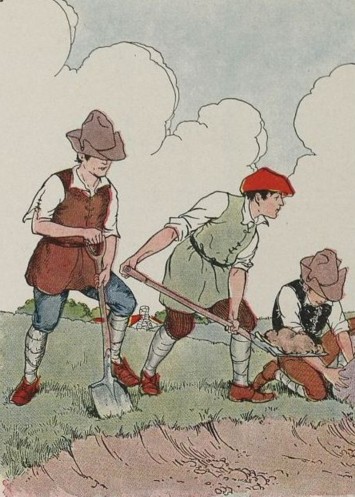London-based storyteller, Olivia Armstrong - Storyteller @Oliviasstories, on X(formerly Twitter) for MythologyMonday said:
Even calling upon the correct god during farming was a task for Roman farmers!
There was Sterculinus, who fertilised the earth, Vervactor who cleared the land for planting, Redarator did the digging, Sator sowed and Occator harrowed ... #Mythology Monday
 |
| Photo by Sheila Terry - Science Photo Library |
Olivia graciously let me reprint her "tweet." When I asked to identify that mosaic, she sent me to Science Photo Library where there is even more information. I was especially interested in its talk of soil exhaustion and erosion. The more marginal land was converted to olive groves and vines and many forms of today's story are set in vineyards. I prefer placing the story over an entire farm.
This month I decided to give here some of the stories related to Thanksgiving or Gratitude Month. At the same time I realize how easy it is to be the overlooked part of what is being called HalloThanksMas.
 |
| (found at https://imgflip.com/i/5todyw) |
One of my favorite stories is an Aesop tale. This fable I first discovered as a picture book called Buried Treasure, so that is the way I think of it. Aesop's short teaching stories have been translated innumerable times, telling this story with varying details just as the facts about Aesop vary. Still the stories date back to the Graeco-Roman times, so the opening information about Roman farmers is appropriate
I chose The Aesop for Children; with pictures by Milo Winter. (No mention of an author, beyond Aesop is given.) Why a children's version when Aesop also fits adults? It tends to give a slightly fuller view of the brief story. I also must comment on giving "the moral of the story." Nowadays such morals are never or rarely given, although it may sometimes be woven into the final action. Why is it now omitted? Besides making these teaching tales "preachy", it is entirely possible the listeners may each have appropriate but different conclusions. The Aesop for Children was published in 1919 and gives a moral at its conclusion. I will give it, but try to avoid reading it first and think of your own conclusion. It may be quite different.
THE FARMER AND HIS SONS

A rich old farmer, who felt that he had not many more days to live, called his sons to his bedside.
"My sons," he said, "heed what I have to say to you. Do not on any account part with the estate that has belonged to our family for so many generations. Somewhere on it is hidden a rich treasure. I do not know the exact spot, but it is there, and you will surely find it. Spare no energy and leave no spot unturned in your search."
The father died, and no sooner was he in his grave than the sons set to work digging with all their might, turning up every foot of ground with their spades, and going over the whole farm two or three times.
No hidden gold did they find; but at harvest time when they had settled their accounts and had pocketed a rich profit far greater than that of any of their neighbors, they understood that the treasure their father had told them about was the wealth of a bountiful crop, and that in their industry had they found the treasure.
Industry is itself a treasure.
***
Have a great, thankful part of Hallowthanksmas!
 |
| (from theodysseyonline.com) |
********************
This is part of a series of postings of stories under the category, "Keeping the Public in Public Domain." The idea behind Public Domain was to preserve our cultural heritage after the authors and their immediate heirs were compensated. I feel strongly current copyright law delays this intent on works of the 20th century. My own library of folklore includes so many books within the Public Domain I decided to share stories from them. I hope you enjoy discovering new stories.
At the same time, my own involvement in storytelling regularly creates projects requiring research as part of my sharing stories with an audience. Whenever that research needs to be shown here, the publishing of Public Domain stories will not occur that week. This is a return to my regular posting of a research project here. (Don't worry, this isn't dry research, my research is always geared towards future storytelling to an audience.) Response has convinced me that "Keeping the Public in Public Domain" should continue along with my other postings as often as I can manage it.
Other Public Domain story resources I recommend-
There are many online resources for Public Domain stories, maybe none for folklore is as ambitious as fellow storyteller, Yoel Perez's database, Yashpeh, the International Folktales Collection. I have long recommended it and continue to do so. He has loaded Stith Thompson's Motif Index into his server as a database so you can search the whole 6 volumes for whatever word or expression you like by pressing one key. http://folkmasa.org/motiv/motif.htm
You may have noticed I'm no longer certain Dr. Perez has the largest database, although his offering the Motif Index certainly qualifies for those of us seeking specific types of stories. There's another site, FairyTalez claiming to be the largest, with "over 2000 fairy tales, folktales, and fables" and they are "fully optimized for phones, tablets, and PCs", free and presented without ads.
Between those two sites, there is much for story-lovers, but as they say in infomercials, "Wait, there's more!"

No comments:
Post a Comment